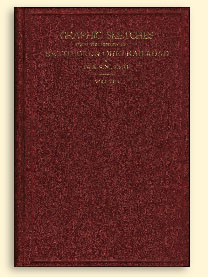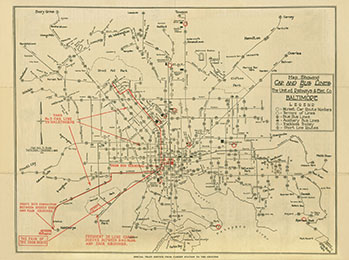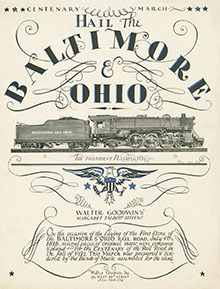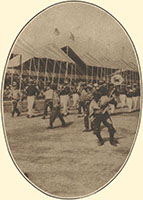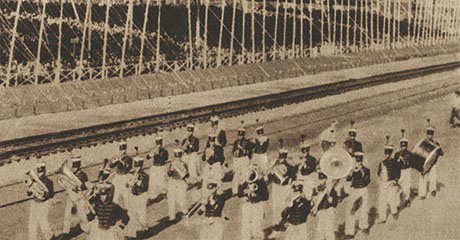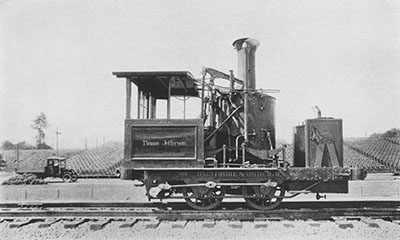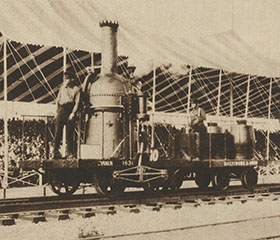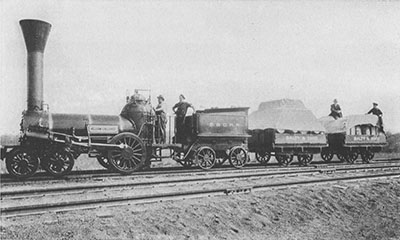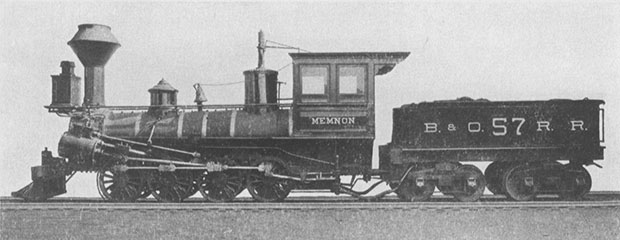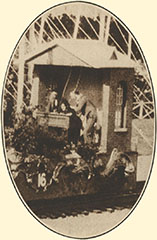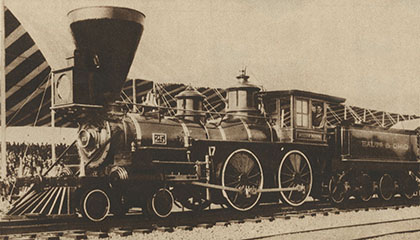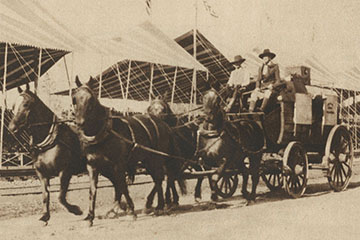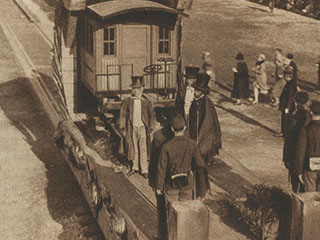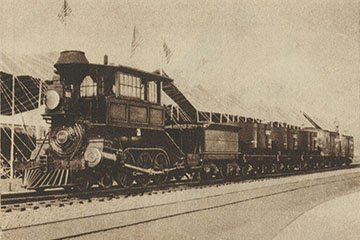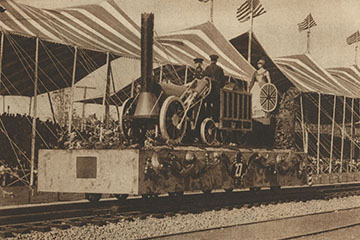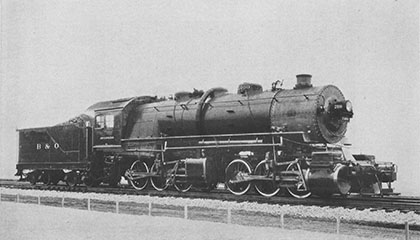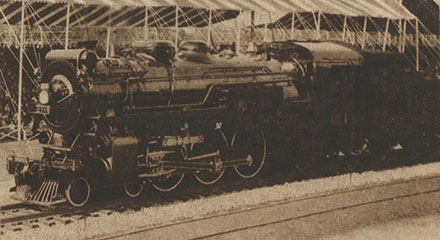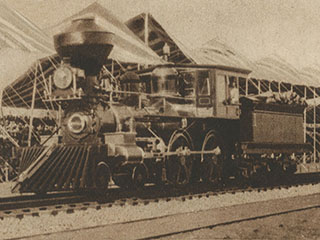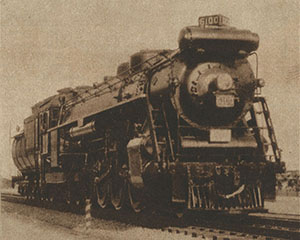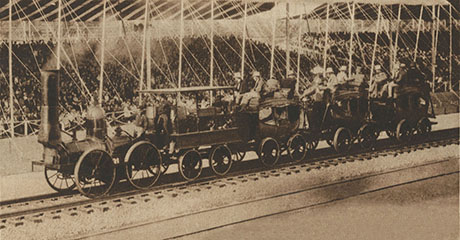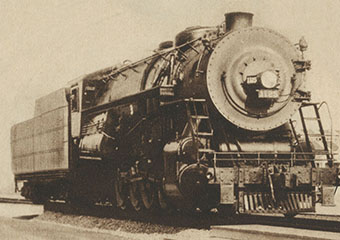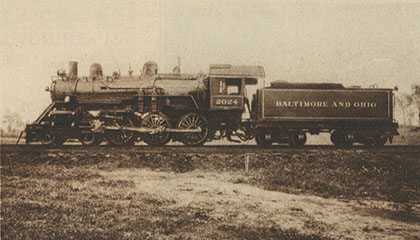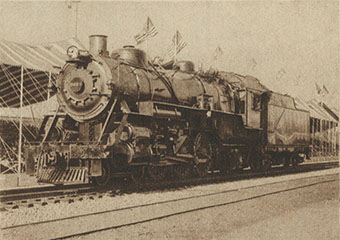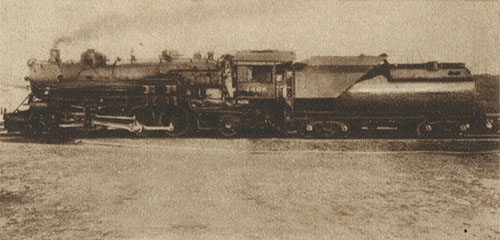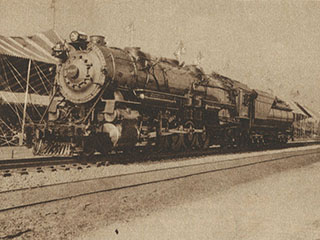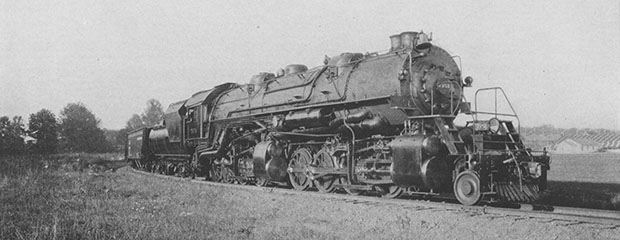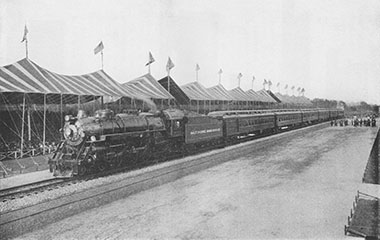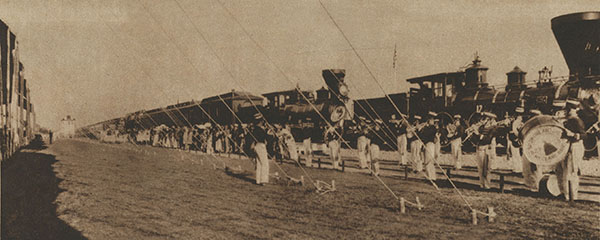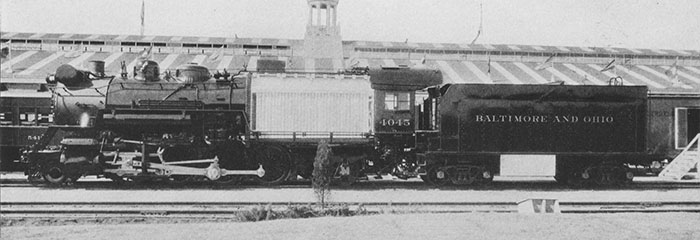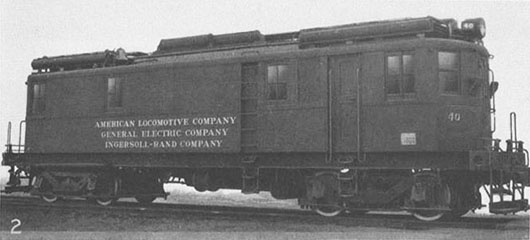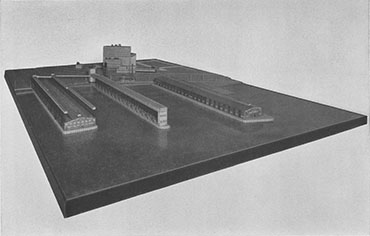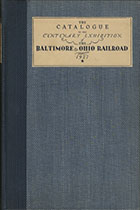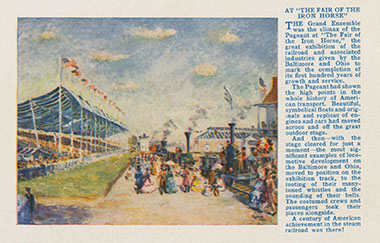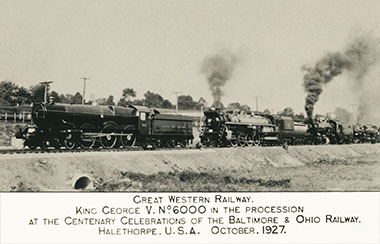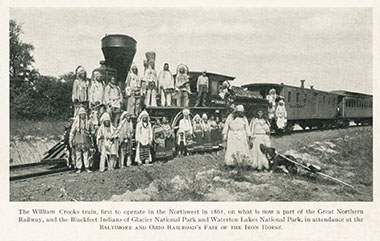

The Baltimore & Ohio Railroad was the first common carrier to be chartered in the US on 28th February 1827. Ground for the new railroad was broken on 4th July 1828 just outside Claremont, MD. The first scheduled service ran from Mount Clare to Ellicott's Mills on 24th May 1830.
The B&O was the country's first Class I railroad, the first to operate a locomotive built in the US, the “Tom Thumb” in 1829, the first to build a passenger and freight station, Mt. Clare in 1829, the first to earn passenger revenues in December 1829, the first to publish a timetable on 23rd May 1830 and, on 24th December 1852, the first to reach the Ohio River from the eastern seaboard. By 1927, the system encompassed over 5,000 miles stretching from St Louis, MO, to New York, NY.
Above, the United Railways & Electric Company produced a special edition of “Trolley News” for the exhibition. The company's #3 trolley line from Druid Hill Park ran through downtown Baltimore and terminated at Halethorpe, where buses were provided to transfer visitors to the grounds.

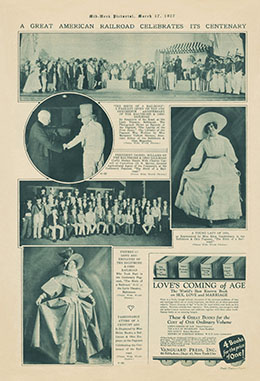
On 28th February 1927, on the one hundredth anniversary of its charter, the company held a celebratory dinner at the Lyric Theater in downtown Baltimore Three scenes were staged depicting significant events in the railroad's history including, above top, “The Laying of the First Stone”. B&O employees dressed in period costume played parts in what was billed as “The Birth of a Railroad”.
Over one thousand guests attended and it was at this dinner that plans were announced to mount an exhibition that would highlight not only “the story of rail transport in the United States, but of all inland transport here since the first settlement of the nation”.


A site was chosen in the suburb of Halethorpe at Halethorpe Farms Rd and Hollins Ferry Rd. Here, the B&O's main line to Washington, DC, crossed a piece of open land where just over one thousand acres were set aside.
Below, an aerial view looking east across the site during construction. The principle feature (middle left just above the main line) was a twelve thousand seat grandstand facing an eight hundred foot long stage with a railroad track, a lane for motor vehicles and another for pedestrians and horsedrawn vehicles.
Baltimore County Public Library Collection
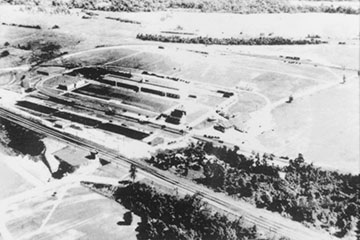
Rail spurs were built south of the right of way for equipment and locomotive access, and
temporary platforms were erected along the
main line for visitors arriving by train. Special services were chartered from as far away as Pittsburgh, PA, to carry passengers to the exhibition. Local trains ran from Camden Station in downtown Baltimore, while a “Frequent De Luxe Coach Service” was provided from the B&O Building, the railroad's headquarters on
N Charles St (the building is now the Monaco Baltimore Hotel).
The exhibition opened on Saturday 24th September for two weeks ending on Saturday 8th October. A quadrangle of buildings, all painted white with blue and white striped roofs, the B&O's colours, surrounded a central “Court of Honor”, which also included the “General Washington Inn” housing the Press Service and exhibition adminstrative staff.
Posters and flyers were printed to promote the show.
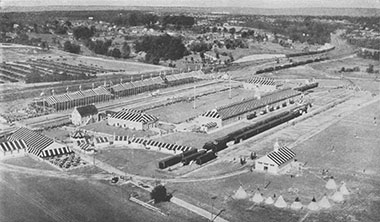
Above, from the second edition of the Centenary Catalogue, an aerial view looking north.
On the upper right, a line of locomotives queue to make their entrance on stage. The grandstand runs diagonally across the middle left. Above the grandstand on the left, cars are still arriving at the parking lot. On the left just below the grandstand, the white walled building with the dark pitched roof is the “General Washington Inn”. To the far left is the large Coffee House with an open air tea garden.
To the right of the Inn, stands the Traffic Building. The arc of structures just below it are concession stands. The Hall of Transportation is directly opposite the grandstand with five exhbition tracks to the rear. At the far right of the “Court of Honor” stands the Allied Services Building.
The small building on the lower right across from the exhibition tracks is the Maryland Pavilion featuring, amongst other exhibits, bas-relief maps of the State, Baltimore harbour and city, as well as displays by the University of Maryland, the State Highway Commission and other state departments. Note the semi-circle of tepees in the open ground behind the pavilion. These had been erected by members of the Blood and Piegan tribes of the Blackfoot Nation, who had travelled to appear for the duration of the fair from their reservation in Glacier Park. MT.
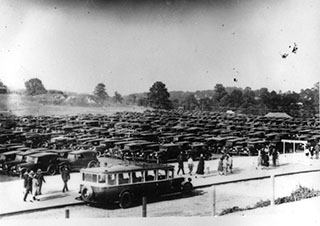
Baltimore County Public Library Collection
Above, one of the parking lots. The visitors appear to be leaving the exhibition.
Newly designated US Route 1 passed a little further to the north, and the lots could accomodate nine thousand cars, a recognition of the accelerating growth of car ownership in the 1920s.

Baltimore County Public Library Collection
Above, crowds throng the stage area. The main grandstand is on the left, the Allied Services Building middle distant and the “General Washington Inn” is on the right.
The B&O had a reputation for providing some of the finest meals of any US railroad, and the crowds were catered for on site. Below, cooks working at a kitchen range.
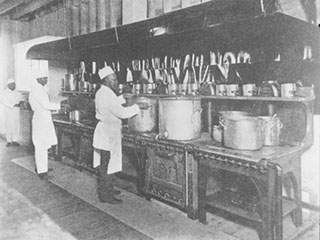
Baltimore County Public Library Collection
Probably mindful of safety with as many as thirty-one locomotives fired up at once, the railroad ensured the Baltimore County Fire Department in Halethorpe was on standby.
Below, two volunteers pose with Engine #5, a 1913 American LaFrance.
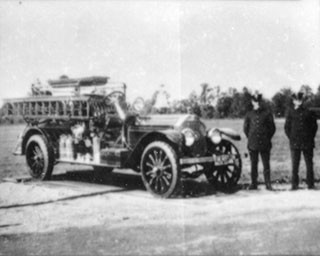
Baltimore County Public Library Collection

The great hit of the exhibition was the pageant known as “The Fair of the Iron Horse”, a series of changing “scenes” illustrating the development of inland transportation in America accompanied by music arranged by the composer Sigmund Spaeth. Narration by the actor Charles Coburn was made possible by a then state-of-the-art public address system, with words by Margaret Talbott Stevens, Associate Editor of the Baltimore & Ohio Magazine.
The pageant was staged Tuesday to Saturday at 2.15 pm with an initial expectation of eighteen to twenty thousand daily attendees. However, numbers quickly
soared to forty to sixty thousand and, on 1st Ocober, seventy-six thousand passed through the gates. The pageant was soon rescheduled daily except Sundays and, when the exhibition was extended for a third week, it ran twice each day at 11.00 am and 2.30 pm including Sunday 16th October.
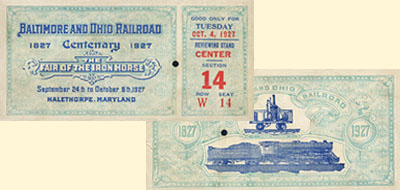
Above, tickets were issued with assigned seats.
The pageant traversed a four mile long loop track from dressing rooms at the rear of the plot, past the grandstand and back to where it started.
It took an hour and a quarter for the parade to pass by which, if placed end to end, would have stretched more than four miles.
Above, the pageant opened with entrance of the seventy-member Baltimore & Ohio Centenary Band marching to its place in the raised stage opposite the grandstand. It was one of two bands that provided musical accompaniment throughout the pageant (the second, Mount Clare Band, is shown later on this page).
Below, the first float to appear, entitled "America", bears the forty male member Baltimore and Ohio Glee Club. Stopping before the grandstand the gentlemen launch into the "Star Spangled Banner", "Hail the Baltimore & Ohio" and "I've Been Working on the Railroad".
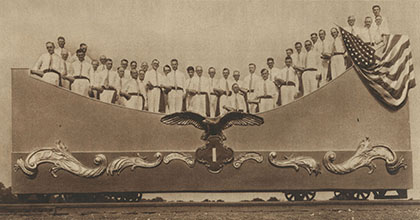
The fourteen rail floats were individually powered, each with a driver hidden from view under the float's apron.
Both these illustrations are from the large, thirty-two page Centenary Brochure apparently given to all attendees, with additional copies priced at 10c.

Control of the parade was in the hands of Adele Gutman Nathan, who had supervised the staging of the historical tableaux at the Lyric Theater earlier in the year. She is shown above at her post in the specially built signal tower at the east end of the grandstand. Telephone contact with the entrance points, exits, dressing rooms and band stand ensured her effective command of proceedings. Locomotives, already fueled and in steam, queued on a spur track to the east of the signal tower awaiting their turn to be ushered onto the stage by Mrs Gutman Nathan.
Preparations had actually been underway for over a year and, when the fair opened, over six hundred people, mainly workers for the Baltimore & Ohio, were employed on site. Olive Dennis, the first woman civil engineer employed on a US railroad, played a major role, among other duties designing costumes for re-enactors.
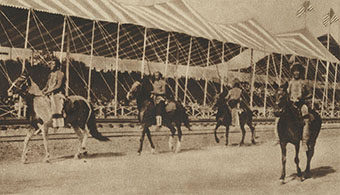
The cavalcade of “scenes” got under way with members of the Blackfoot Nation passing in review. At their appearance, according to the souvenir brochure, the audience “went wild with enthusiasm”.

Above, “The Wades-In-The-Water Family. Mr. and Mrs. and the coming generation” an illustration from the souvenir brochure. The travois of the type shown here was described as “symbolic of early highway travel, crude and slow”.
By now familiar hands at this sort of thing, having appeared at a number of expositions and fairs in the past few years, the Native American attendees entertained visitors between shows with “native songs and picturesque dances to the booming of tom-toms”.
Various floats, posed tableaux and vehicles then roll by showing the further evolution of modes of transport “In the Days Before the Railroad”. The exact order appears to have changed according to what is listed in different publications.
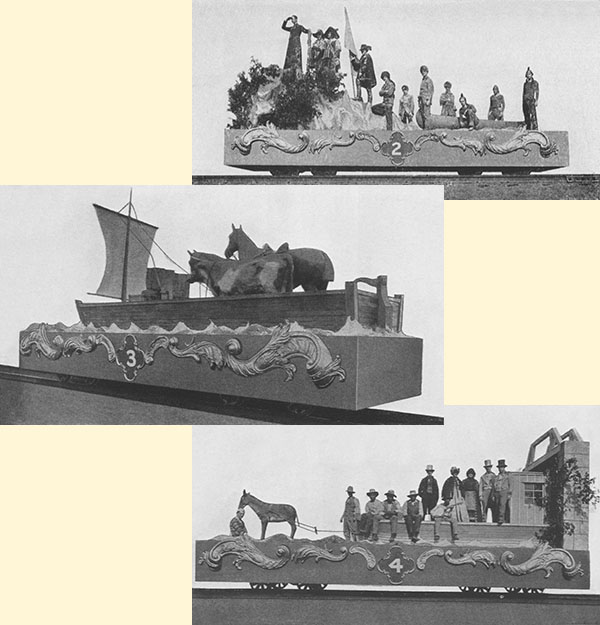
Ironically, given the eclipse of canal transportation by rail later in the nineteenth-century, President Quincy Adams had elected to attend the laying of the first stone of the Chesapeake & Ohio Canal in Georgetown on 4th July 1828, rather than the Baltimore & Ohio's.
First, on the right, Pere Marquette accompanied by Joliet is shown sighting and blessing the Mississippi River along with two of his aides and three Native Americans “at the business of portaging”.
Next to appear is what is listed as an “old fashioned river bateau, a queer-looking boat
pointed at either end, very deep like a dory, and equipped with a crude sail”.
Then, right, “Canal Days”, a float bearing an example of a horse and canal boat of the type used on the Chesapeake and Ohio canal.
“Several colored boys play and sing old plantation songs”.

Depending on the publication or photos consulted, these included (not shown here): bullock carts, a “Gentleman’s Carriage” of 1775”, a Prairie Schooner, a “George Washington” coach in which we see Henry Clay “[e]arly idol of America, as depicted by Mr. Joseph Swiekert” riding over the National Road. These photos are from the second edition of the Centenary Catalogue.
Right, a “number of negroes moving large hogsheads of tobacco” follow in procession, representing yet another “crude method of freight transportation”.
Left, a pitch-backed Conestoga Wagon. According to the catalogue, these represented the “fast freight” of their day.
Right, the “Kearsage”, a coach built in 1813 on loan to the fair from the Henry Ford collection.
It can still be seen at the Henry Ford Institute in Dearborn, MI.
Left, a four horse stage coach, which was built at about the time the B&O was inaugurated.
Several other wagons and coaches were featured in the pageant.
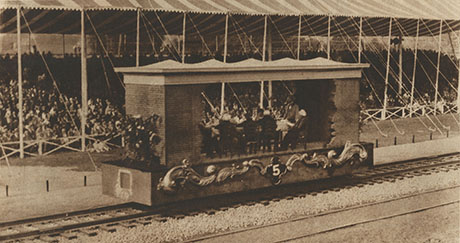
Above, “The Birth of the Railroad”, a float depicting a meeting of the founders of the Baltimore & Ohio in February 1827.
Left, “Street Gamins” follow the parade, as the scene turns to a representation of the historic 4th of July 1828 parade through the main street of Baltimore City, held in honour of the laying of the “First Stone”.
Next, below, the Mount Clare Band marches past playing the “Rail Road March”, which had been performed at the original parade. The Glee Club then sings “Hail to the Chief”.
The “First Stone” rides by in an open cart . You can see the “First Stone” and learn more about it on the B&O Museum Roundhouse page of this website.
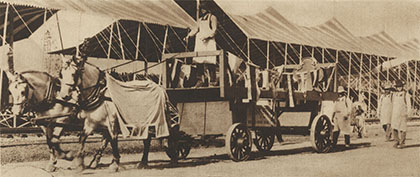
The 1828 parade excited great interest, the town “packed to overflowing”. Local trades had furnished some fifty or so different floats, each accompanied by fifty to one hundred and fifty of their members.
The three examples reconstructed for the fair were based on “carefully preserved documents of the day”.
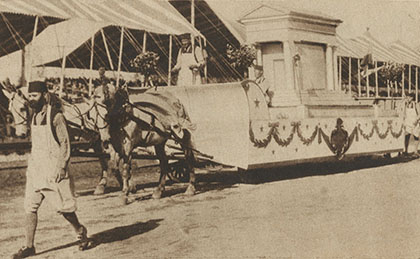
Above, the carpenters displayed a miniature temple with portico and pediment in the Doric order.
A banner (not evident in the image above) was carried at the head of the float showing a locomotive approaching the centre door of a railroad station with a Doric arcade.
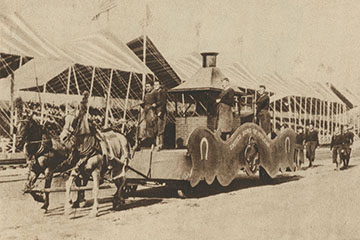

Top, the city’s blacksmiths are represented by a float depicting the “Sons of Vulcan”, the sailors, middle, by a model of the brig “Union”. Next, below, a float represents Captains McNeil and Whistler with Lieutenant Thayer from the US Army making the first survey for the B&O Railroad.
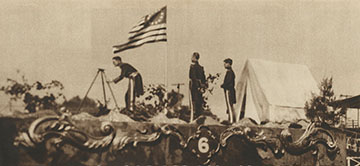
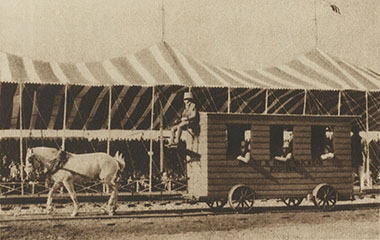
The first services on the B&O were drawn by horses. The replica “Pioneer” above was built at the B&O’s
Mt. Clare shops in 1892 for the 1893 World’s Columbian Exposition held in Chicago, IL. The
original “Pioneer” was built by Richard Imlay and carried the B&O company directors on the railroad’s inaugural trip from Mt. Clare to Ellicott’s Mills on 22nd May 1830.
You can see photos of the “Pioneer” on the B&O Museum Roundhouse page of this website.

Above, another view of the “Pioneer” from the second edition of the Centenary Catalogue published in late 1927.
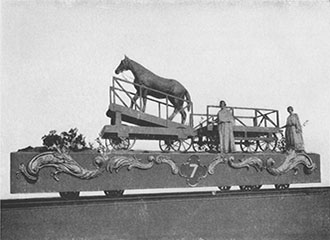

Above, examples followed of two of the “crude devices” tried as motive power by the fledgling B&O. Top view, a model of the horse-powered “treadmill car” tested briefly in 1831. On a trial run in June that year, the front passenger car collided with a cow and was derailed. No-one was seriously injured, but the experiment was abandoned.
Lower view, the disadvantage of the “sail car” was that it needed quite strong winds to keep it moving. Although quickly abandoned by the B&O, it piqued the interest of the Russian Ambassador, Baron de Krudener, who had a model sent to Tsar Nicholas 1.
Right, a replica of the “Tom Thumb” built in 1927 at the B&O’s Mt. Clare shops for the fair. The original, the first steam engine to operate on the B&O, was built in 1830 by Peter Cooper. On 28th August that year, it hauled the B&O Directors from Mt. Clare to Ellicott’s Mills.
You can see photos of the replica and find out more about it and the original on the B&O Museum Roundhouse page of this website.
Below, the “William Galloway” is a replica of the “Lafayette”, a 4-2-0 built by the B&O specifically for the fair and named after the grandfather of the railroad’s then operating Vice-President, Charles W. Galloway. The original was built by William Norris at the Norris Locomotive Works in Philadelphia, PA, in 1837, and was the first horizontal boilered locomotive to operate on the B&O.
As shown below, the “William Galloway” hauled two flour cars, “typical of its day”, in the parade. You can see photos of it on the B&O Museum Roundhouse page of this website.
Left, a replica of the “York” was also built in 1927 at Mt. Clare for the fair. The original was built by Davis and Gartner in York, PA.
Following the success of the “Tom Thumb”, in 1931, the B&O offered a $4,000 prize for the best steam locomotive and four models were tested. Not much is known about how the others performed, but the “York” confirmed that steam power could meet the needs of the railroad.
The “Atlantic” was followed by what was listed in the running order as the “Thomas Jefferson”. The photo above, from volume one of Edward Hungerford’s “The Story of the Baltimore & Ohio Railroad 1827-1927” shows the locomotive at the site of the fair.
The locomotive had, in fact, been built as the “John Hancock” by George Gillingham and Ross Winans in 1836, but was incorrectly named the “Thomas Jefferson” when it was rebuilt in 1892 for display at the 1893 World’s Columbian Exposition in Chicago, IL You can see photos and learn more about it on the B&O Museum Roundhouse page of this website.
The “York” was retired after one year when another Davis and Gartner engine, the “Atlantic”, was acquired. This also had a short life: it was scrapped in 1835.
The “Atlantic” displayed at the fair, right, was actually the “Andrew Jackson” #7, built in 1836, and adapted in 1892 for the 1893 Columbian Exposition in Chicago, IL. You can see photos of it on the B&O Museum Roundhouse page of this website.
The replica “York” has also been preserved. You can see photos and find out more about it on the Chicago Museum of Science and Industry page of this website.
Above, the “Memnon”, built in 1848, follows the “William Galloway”. Find out more about this locomotive on the B&O Museum Roundhouse page of this website.
Below, following the “William Mason”, there is a depiction of Abraham Lincoln travelling over the B&O from Springfield, IL, in February 1861 to his inauguration as President in Washington, DC. The trip took ten days and enormous crowds came out to greet him (two hundred and fifty thousand in New York City). It was during this trip that Lincoln grew his beard at the behest of eleven year old Grace Beddell.
Below left, Lincoln was played at the fair by G. W. Bangs.
Above, this American type
(4-4-0) locomotive was built by the Mason Machine Works in Taunton, MA, in 1856 for the B&O as #25. It was renamed “William Mason” for the fair in honour of the owner of the machine works where it was originally made.
You can see the “William Mason” and find out more about it on the B&O Museum Roundhouse page of this website.
Top left, a double float now makes its appearance commemorating the “Birth of the Telegraph”. Before it, a placard bears the words “What Hath God Wrought” (not evident in this vignette), the first commercial telegraph message ever transmitted from Washington, DC, along the Baltimore & Ohio line to Baltimore station on 24th May 1844. Professor S. F. B. Morse is depicted seated at his desk.
Top right, the scene then shifts to the highway with a Pony Express ride-by exemplifying another early form of communication. This is followed, lower image, by an early Wells Fargo coach contributed to the pageant by the American Railway Express Company.
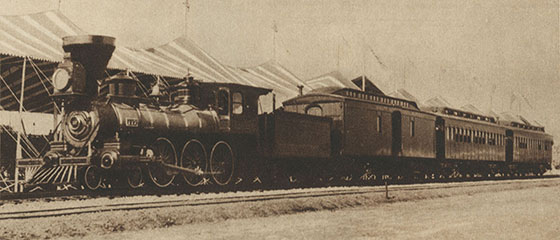
You can see photos of the “Thatcher Perkins” and find out more about it on the B&O Museum Roundhouse page of this website.
Left, #147 was one of eleven Ten Wheeler
(4-6-0) type locomotives designed by B&O Master of Machinery, Thatcher Perkins, and built at the Mt. Clare shops in 1863. The new Ten Wheelers were built to meet increased traffic needs during the Civil War.
The locomotive was named “Thatcher Perkins” for the fair in honour of its designer.
Far left, a float depicts Union troops tearing up tracks on the B&O during the Civil War. Rails were heated until malleable and then wound around trees. The twisted rails were soon dubbed “Sherman’s neckties” after Union General Sherman.
Near left, two of the cast dressed as Union soldiers.
Right, the “Camel” locomotive that next appears was built in 1869 at the B&O Mt. Clare shops as #305 and subsequently renumbered #187 in 1884. A “Camel” has its cab mounted on top of the boiler, and the type was well established as a freight hauler on the B&O. The first “Camel” was built for the railroad by Ross Winans, after whom #305 was named for the fair.
You can see photos of the “Ross Winans” and find out more about it on the B&O Museum Roundhouse page of this website.
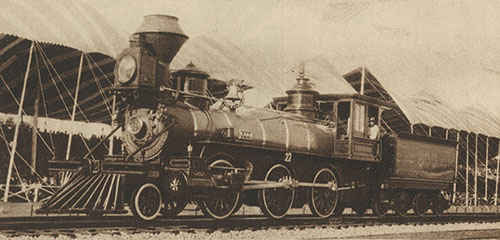
You can see photos of the “J C Davis” and find out more about it on the B&O Museum Roundhouse page of this website.
Left, #600 was built at
the B&O’s Mt. Clare shops in 1875 under the supervision of Master of Machinery, John C. Davis. It won first place at the US Centennial Exhibition in Philadelphia, PA, in
1876, where it was displayed as the
heaviest locomotive in the world.
It was named “J C Davis” in 1893.

Below, the next float represents “The Coming of the Electric Locomotive 1895” bearing Baltimore & Ohio #1, which hauled the first train pulled by an electric locomotive through the Baltimore & Ohio Belt Line on 27th June 1895. The Belt Line routed the B&O’s lines under the City of Baltimore.
Built by General Electric and originally powered by an overhead catenary, #1 was later converted to the third-rail system but has not survived.
Right, built in 1904 by Alco, 0-6-6-0 #2400 was the first articulated locomotive produced in the US. It was named after its designer John E Muhlfield, then the B&O’s General Superintendent of Motive Power. A compound locomotive, it weighed
334,565 lbs and had a 206,400 lb tender (light). Operating at a boiler pressure of 235 psi, it had a 72.2 sq ft grate, 219 sq ft firebox, 20” x 32” high pressure and 32” x 32” low pressure cylinders and delivered 65,664 lbs tractive effort.
Affectionately known as “Old Maud” after the comic strip mule, #2400 was scrapped in 1938.
Baltimore County Public Library Collection
Above, #545 a 4-6-0 built in 1885, was renamed in honour of its designer, Master of Machinery Andrew J. Cromwell, for the fair.
Both the “A. J. Cromwell” and “J. C. Davis” were badly damaged in the 2003 roof collapse at the B&O Railroad Museum in Baltimore, MD. You can see them in damaged state on the B&O Museum Roundhouse page of this website. #545 was restored and returned to display in 2012, and you can also see photos of it on the B&O Museum Roundhouse page.
Left, #1310 was one of six Ten Wheeler
(4-6-0) type locomotives built for the Baltimore & Ohio by Burnham, Williams & Co., an early incarnation of the Baldwin Locomotive Works, in 1896. They were purchased to haul the Royal Blue passenger service between Washington, DC, and New York, NY. The engine weighed 154,230 lbs. The tender weighed 102,200 lbs light with a capacity for 5,000 gallons of water and 10.5 tons of coal.
With 21” x 26” cylinders, a 32.47 sq ft grate and 181.4 sq ft firebox, they operated at a boiler pressure of 190 psi delivering 23,741 lbs tractive effort.
The float introduced the three locomotives taking part in the pageant from outside the US, starting with the Great Western Railway’s King Class “King George V” #6000 shown, right, waiting to make its entrance.
A 4-6-0, the locomotive was built at the GWR’s works in Swindon in the United Kingdom for fast passenger service. Just three months old when it appeared at the fair, this 104,600 lb four cylinder compound behemoth was then the most powerful locomotive in Great Britain. With a 194 sq ft firebox and total heating surface of 2,008 sq ft, including 313 sq superheating surface, it operated at a boiler pressure of 250 psi and delivered 40,300 lbs tractive effort.
Below, following GWR #6000 in the parade, Canadian National Railway #6100 was the first of twenty Northern type
(4-8-4) locomotives ordered in 1927 from the Canadian Locomotive Company in Kingston, ON. They were dubbed “Confederation” type locomotives to celebrate the 60th anniversary of Canadian Confederation.
When it made its appearance at the fair, this was the largest locomotive in the British Empire.
Left, Canadian Pacific Class G-3-d #2333, a Pacific (4-6-2) type locomotive, was built by the Montreal Locomotive Works, a subsidiary of Alco in 1926. Another CPR G-3-d, #2341 is also listed as appearing at the fair in different publications. The G-3-d weighs 306,500 lbs. With 23” x 30” cylinders, a 65 sq ft grate, 291 sq ft firebox and total heating surface of 4,136 sq ft, including 864 sq ft superheating, it operated at a boiler pressure of 250 psi delivering 44,965 lbs tractive effort.
Neither #2333 nor #2341 has survived.
Following the “J E Muhlfield”, the pageant turns from the B&O to locomotives from other railroads.
Left, a float appears representing “England, the Mother of Railways” and recognising the country as the birthplace of modern railroad operations in 1825. As the daily program described it, “[u]pon this float one sees the Rocket, the famous Stephenson locomotive which made a sensational success at the Rainhill Trials, outside Liverpool, in 1829. George Stephenson is shown standing by his locomotive”. The Rocket displayed on the float is a replica, but I haven't been able to identify when it was built or whether it has survived.
#6100 weighed 396,390 lbs. It had a 84.4 sq ft grate, 415 sq ft firebox and total heating surface of 6,084 sq ft, including 100 sq ft of water tubes in the firebox and 1,840 sq ft superheating. With 25½” x 30” cylinders it operated at 250 psi delivering 56,786 lbs tractive effort.
#6100 has not survived.
Above, after #2333 had passed by, the pageant turns to locomotives visiting from other US railroads with a replica of the “De Witt Clinton” built by the New York Central in 1893 for the World’s Columbian Exposition in Chicago, IL. The original was designed by John B. Jervis and built by David Matthew at the West Point Foundry for the Mohawk & Hudson in 1831.
The Henry Ford Museum page of this website has photos and more information about this replica of the “De Witt Clinton”.
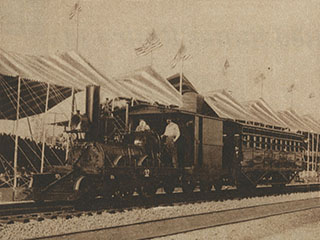
The “John Bull” is preserved in the Museum of American History in Washington, DC.
Next, the “John Bull”, left, one of the earliest locomotives imported to the US from the United Kingdom. Built in 1831 by Robert Stephenson & Co., Newcastle, it went into service on the Camden & Amboy in 1833. The C&A was absorbed by the Pennsylvania Railroad in 1871.
The “John Bull” is followed by, top, the Atlantic & Gulf “Satilla”, now preserved in the Henry Ford Museum in Dearborn, MI, and then, lower photo, the St Paul & Pacific “William Crooks”, in 1927 owned by the Great Northern. It is now on display in the Lake Superior Railroad Museum in Duluth, MN.
Right, New York Central #5205 next appears (#5200 is also listed as participating). This was one of the first Hudson type (4-6-4) locomotives built. The first batch of two hundred and five was delivered to the NYC by Alco on 14th February 1927.
The #5200s weighed 346,500 lbs. With a 81.5 sq ft grate, 281 sq ft firebox, 6,435 sq ft total heating surface including 1,951 sq ft superheating and 25” x 28” cylinders, they operated at a boiler pressure of 225 psi delivering 42,366 lbs tractive effort.
Left, the Pennsylvania Railroad sent along one of its latest 4-6-2 Pacific type locomotives. K4s Class #5475, was one of seventeen built at the railroad’s Altoona, PA, workshops in 1926, and another locomotive designed for high speed passenger service.
PRR K4s #3877 built in 1923, and PRR M1 #8800, a Mountain (4-8-2) type, possibly M1 #6800 incorrectly numbered, are also listed in the different publications and may have substituted for #5475.
Right, the Delaware & Hudson Railroad’s “John B Jarvis” #1401. Built in 1927, this 2-8-0 was the second in the railroad’s three experimental two cylinder cross compound locomotives. All three were fitted with water tube boilers of a design by John Muhlfield, by then working as a consultant for the D&H. #1401’s boiler had an operating boiler pressure of 400 psi.
The locomotives were designed to
haul heavy freight trains but, underneath the cowling, the fearsome piping proved to have very high maintenance needs.

No NYC Hudsons have survived. One PRR K4s has (you can see #3750 on the Pennsylvania Railroad Museum Yard page of this website). The “John B Jarvis” had been removed from service by 1935 and scrapped soon after.
Left, “Lord of the High Hills” Western Maryland Class I-2 #1125 is one of twenty Decapod (2-10-0) type locomotives built for the railroad by Baldwin in 1927 (#1111-#1130).
WMR I-2 #1112 is also listed as participating in the
pageant. They were designed to haul heavy coal trains over the Allegheny mountains in Maryland, West Virginia and Pennsylvania.
Weighing 419,280 lbs, the I-2 had a 104.5 sq ft grate, 503 sq ft firebox and total heating surface of 5,822 sq ft, including 1,248 sq ft superheating. With 30” x 32” cylinders and operating at a boiler pressure of 240 psi, it delivered 96,315 lbs tractive effort.
Below, B&O Class P1-c Pacific type (4-6-2) #5005. P1-c #5039 is also listed as participating. Both locomotives were part of a batch of thirty Q-1 Class 2-8-2 Mikados converted to 4-6-2s at the Mt. Clare workshops in 1924 (the Q-1 locomotives were built in 1911 by Baldwin). The rebuilt locomotives weighed 299,000 lbs. With 26” x 28” cylinders, total heating surface of 3,936 sq ft including 811 sq ft superheating, they operated at a boiler pressure of 205 psi delivering 44,600 lbs tractive effort.
Neither locomotive has survived.
Above, “recently modernised” B18-A Class Ten Wheeler
(4-6-0) type locomotive #2024 was decked out in the B&O’s green, black and gold passenger livery. This was arguably a slightly unusual choice for inclusion by the B&O as it had little historic interest and was already over a quarter century old in 1927.
Built as cross compounds in 1901 by the Rhode Island Locomotive Works (later part of Alco), the locomotives
were simpled by the B&O in 1908 with 21” x 28” cylinders and were used primarily for local passenger service. With Stephenson valve gear and weighing 173,400 lbs, the
B18As had 35.14 sq ft grates, a 223 sq ft firebox and a total heating surface of 2,631 sq ft. Operating at a boiler
pressure of 200 psi, they delivered 30,870 lbs tractive
effort.
Left, B&O Class Q4-b #4465, a 2-8-2 built in 1922 (Class Q4 #4400 is also listed as participating in the pageant depending on the publication, and Q4-b #4480 may also have attended). The Q4s were designed for passenger service by George H Emerson, Chief of Motive Power at the B&O and built by Baldwin from 1921 to 1923. They weighed 327,400 lbs. With 26” x 32” cylinders and operated at a boiler pressure of 220 psi delivering 63,206 lbs tractive effort.
No Q4s have survived.
Right, B&O Class S-1a #6200, a Santa Fe (2-10-2) type locomotive,
was one of twenty-five built in 1926 by the Lima Locomotive Works (B&O S-1 2-10-2 #6137, built in 1924 by Baldwin, is also listed as participating and may have substituted for #6200 on occasion). The
S1-a weighed 436,810 lbs. It had a 88 sq ft grate, a 375 sq ft firebox
and total heating surface of 6,763 sq ft, including 38 sq ft in five arch tubes, a 67 sq ft combustion chamber and 1,512 sq ft superheating. With 30” x 32” cylinders and operating at a boiler pressure of 220 psi, it delivered 84,150 lbs tractive effort.
Known as the “Big Six” from the number of the lead engine, they were designed by George H Emerson, Chief of Motive Power for the B&O. The last S-1a was retired in 1959 and none has survived.
Above, B&O Class T, a Mountain (4-8-2) type locomotive, is listed in the Centenary catalogue as the “Phillip E Thomas” #5501.
The photo is, however, likely a retouched photo of #5500 the “Lord Baltimore”.
Following the “Phillip E Thomas”. the final float in the procession depicted the State of Maryland personified as a classical figure enacted by “Miss. Gladys Millar of the Baltimore & Ohio office forces” with the State’s great seal in her hand.
At her feet was arrayed a model of the City of Baltimore, “with its trains and ships emblematic of the great commerce that currently passes through”.
Left, middle photo, #5300 and six coaches of the Capitol Limited pull up in front of the grandstand.
The Chicago-Washington-Baltimore Capitol Limited express was inaugurated that summer, and was the railroad’s crowning glory. Unveiled at the fair, #5300 was one of twenty new P7 Class locomotives.

Baltimore County Public Library Collection
Left, named after the first President of the B&O, #5501 was built in 1926 at the Mt. Clare shops using the boiler from B&O #6030, a Class S
2-10-2 built by Baldwin in 1914. Like #5500, it was designed to test the Emerson watertube firebox. 400,000 lbs in weight with a 89.17 sq ft grate, 383 sq ft firebox, total heating surface of 6,898 sq ft and 30” x 30” cylinders, it operated at 210 psi delivering 65,128 lbs tractive effort.
Neither #5500 nor #5501 has
survived.
Above, BO Class EL-5a #7151, a 2-8-8-0, waiting on the spur
to haul a short, twelve car freight past the stand (#7159 may have substituted for #7151).
The EL-5a started life as L-5 Class compound Mallets, built by Baldwin in 1916. From 1927, the seventy-one locomotives were progressively simpled. Rebuilt with four 24” x 32” cylinders, their weight dropped 1,200 lbs to 484,400 lbs. With an 88.17 sq ft grate, 341 sq ft firebox and total heating surface of 7,199 sq ft, including 1,415 sq ft superheating, they operated at a boiler pressure of 22 psi delivering 113,452 lbs tractive effort, an increase of 21% on the original compounds.
They worked mainly on heavy drag freight in the mountainous parts of the system until the 1950s. None has survived.
They were built by Baldwin in 1927 for the New York- Washington Royal Blue service. A transfer of passengers to motorbuses is then enacted, as at B&O’s Jersey City terminal, to travel into New York City.
You can see photos of #5300 on the B&O Museum Yard and Car Shop page of this website.

Above, finally, the crowd is asked to join in singing “America”, after which the enactors march by while the band plays the “Railroad March” of 1828 and the “Centenary March” of 1927.
Below, the pageant in general order of appearance at its most comprehensive (showing possible locomotive substitutions where known):
“America” with Baltimore & Ohio Glee Club
Native American Indians
Pere Marquette
River bateau
Road wagon with pioneers and their families
Post chaise
Post rider
Canal boat
Tobacco Rollers
Conestoga wagon
“George Washington” coach
Early 19th century coach
The “Kearsage” coach
The Birth of the Baltimore & Ohio
Mount Clare Band playing the “Carrollton March"
The “First Stone”
The “Sons of Vulcan”
The “Doric Temple”
The “Union”
Coach with Phillip E Thomas, first B&O President
Surveyors laying out the new road
The “Pioneer” horse car
The Treadmill car
The Sail car
B&O Tom Thumb (1927 replica)
B&O York (1927 replica)
B&O Atlantic #2 (adapted from the Andrew Jackson #7 in 1892)
B&O Thomas Jefferson
B&O William Galloway (1927 replica of the Lafayette #13)
B&O Memnon #57
The Birth of the Telegraph
Wells Fargo coach and Pony Express rider
B&O William Mason #25
Mr Lincoln Goes to Washington
B&O B Thatcher Perkins #117
Destruction of the Baltimore and Ohio Tracks
B&O A Ross Winans #217 (built as #305)
B&O J C Davis #600
B&O E-8 A J Cromwell #545
B&O LE-1 Electric Locomotive #1
B&O B-14 #1310
B&O Muhlfield DD-1 #2400
Stephenson’s Rocket (replica)
GWR King George V #6000
CNR U-2-a Confederation #6100
CPR G-3-d #2333 (CPR G-3-d #2341 a possible substitute)
MH De Witt Clinton (1893 replica)
CA John Bull
AG Satilla #3
SPP William Crooks #1
NYC J1B #5205 (NYC J1a #5200 a possible substitute)
PRR K4 #5475 (PRR K4s #3877 and PRR M1 #6800 possible substitutes)
DH John B Jervis #1401
WM I-2 #1125 (WMR I-2 #1112 a possible substitute)
B&O B-18A #2024
B&O P1-c #5005 (B&O P-1c #5039 a possible substitute)
B&O Q-4b #4465 (B&O Q-4 #4400 and Q-4b #4480 possible substitutes)
B&O S-1a #6200 (B&O S-1 #6137 a possible substitute)
B&O T Philip E Thomas #5501
Maryland
B&O L-5a #7151 (B&O L-5 #7159 a possible substitute)
B&O P7 President Washington #5300
Epilogue
Small engine parade
Singing of “America”
March past with bands playing

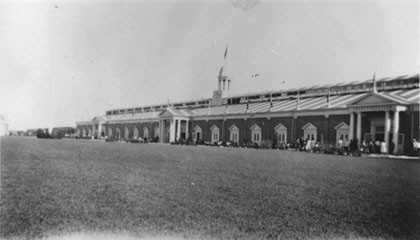
Baltimore County Public Library Collection
Above, the other main attraction at the exhibition was the Hall of Transportation, 502’ long and 62’ wide, with three Doric porticoes fronting onto the “Court of Honor” and topped by a colonial style cupola.
The hall contained static displays dedicated to demonstrating development of the actual working of railroads. Exhibits included stokers, brake equipment, model bridges, carriages, tracks, and many illustrations on the walls or on standing easels. A 250’ long model showed the “typical” country traversed by the B&O between Baltimore and Chicago.
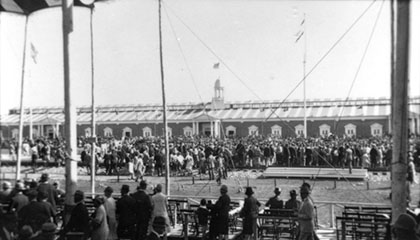
Baltimore County Public Library Collection
Above, crowds throng to the hall after the afternoon pageant has concluded.

Above, four of the model bridges exhibited in the Hall of Transportation. From the top, a wooden truss bridge, a Pratt Truss, a Scherzer Rolling-Lift and a Bollman Through Truss.
Photos from the Centenary Catalogue.
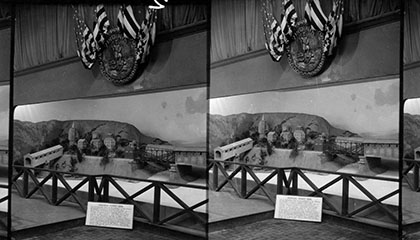
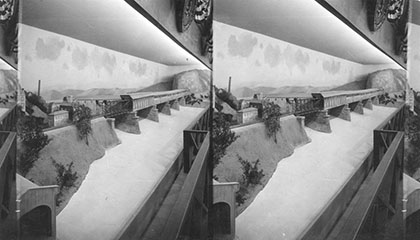
Both images above Keystone-Mast Collection, UCR/California Museum of Photography, University of California at Riverside
Above, two views of a 60’ long, 12’ deep and 8’ high scale model of Harpers Ferry as it appeared in 1859, “the year in which John Brown of Ossawatomic conducted his epoch-making raid upon the United States arsenal”. The State Seals of Maryland, Virginia and West Virginia hang above the model.
The 700’ long covered bridge carried the B&O rails and highway across the Potomac River and the Chesapeake & Ohio canal, and had the distinction of containing a railroad junction at its centre. The bridge was destroyed by Stonewall Jackson in June 1861 as the Confederate Army retreated. Two separate bridges were later built for the rail line and highway.
Below, some of the thirty-two examples from the “Pangborn Collection of Wooden Locomotive Models”. These life-size models were built by J. G. Pangborn of Baltimore for the B&O exhibit at the 1893 World’s Columbian Exposition.
From the top: Oliver Evans’ Scow, a Seguin, B&O “James II”and the“South Carolina”. a 2-2-2-2 double-ended locomotive.

Photos from the Centenary Catalogue.
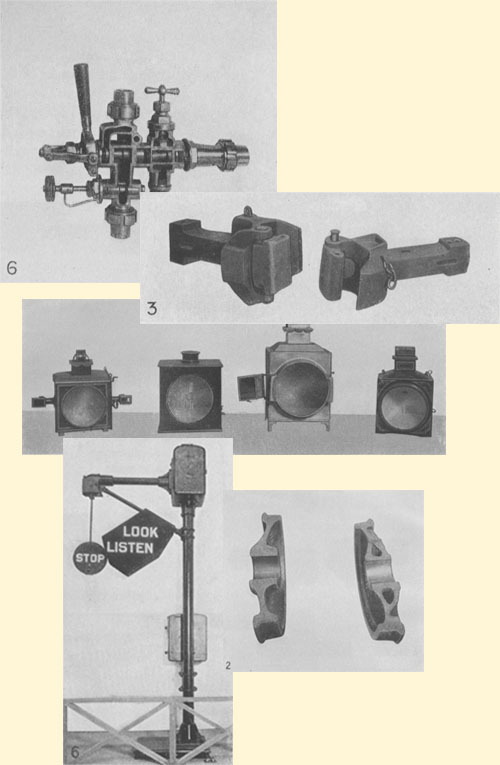
Photos from the Centenary Catalogue.
Amongst the many other exhibits on display in the Hall of Transportation there were, left and below, cutaway models of injectors, different types of car couplers, locomotive headlamps, railroad signals and car wheels.


Outside and adjacent to the Hall of Transportation, ten sections of track showed the development of rails and construction of rail beds from 1836 to the present. Above, from the top, examples of the Wood String and Sleeper, Stone Sill, Wood String and U-Rail and Cross Tie and John Brown Rail.
When not rolling in the pageant, locomotives were assembled on a set of tracks behind the Hall of Transportation. Several other locomotives mentioned as on display there include, below, a 1925 replica of the Great Western Railway 2-2-2 “North Star”.
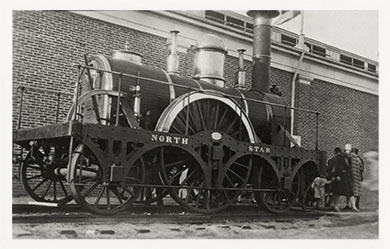
The replica “North Star” is now at the Swindon Steam Railway Museum in the United Kingdom.
Left, The Great Western published a souvenir booklet for the fair, touting itself as offering the quickest route between New York and London. You can browse the booklet and download a pdf version on this website.
#6000, “King George V”, shown earlier on this page, and the “North Star” exemplified the earliest and latest types of locomotive used by the railway. At the time each engine went into service (1837 and 1927), they were the most powerful passenger locomotives in the British Isles. The “North Star” was built by Robert Stephenson & Co., in 1837 for the New Orleans Railway but, because of financial difficulties, was not shipped to the US. It was bought by the GWR the same year.

© Nova Scotia Museum of Industry
Above, Albion Mines Railway “Samson” in 1950. Built by Timothy Hackworth in Shildon in England in 1838, and on display at the fair, it was the first steam locomotive to operate in Canada in 1839.
Below, Albion Mines Railway “Albion” on display at the Nova Scotia Museum of Industry.
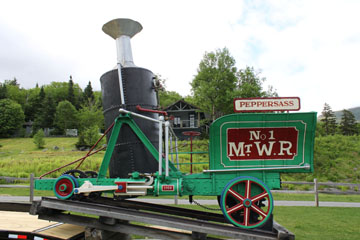
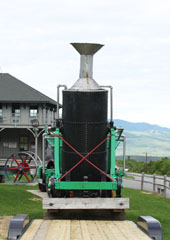
Above, two modern photos of Mount Washington Cog Railway #1, "Peppersass".
The engine was built by Campbell & Whittier in Roxbury, MA, in 1866. It was retired from active service in 1878. At the time of the fair, the engine was in the keeping of the B&O. It was also exhibited at the New York World's Fair
1939-40
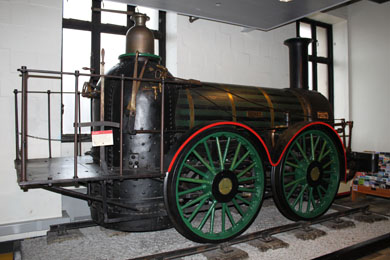
Above, a modern photo of the Philadelphia & Reading “Rocket” #3, which was also on display at the fair.
It was built by the Philadelphia company Eastwick & Harrison in 1842 (you can see photos of “Rocket” on the Franklin Institute page of this website).

© Nova Scotia Museum of Industry
The “Albion” appeared at the fair billed as Canada’s “second locomotive”, but its provenance has since been disputed. Current opinion is that it was likely built as a contractor’s locomotive between 1849 and 1854.
Below, Cumberland Valley Rail Road “Pioneer” #13, also featured at the fair. It was built in 1851 by the Union Works in South Boston, MA. You can see photos of the “Pioneer” on the B&O Museum Roundhouse page of this website.

Below, another historic locomotive on hand at the fair was the Western & Atlantic “General”.
The “General”, with the Western & Atlantic “Texas”, was one of four locomotives involved in the “Great Locomotive Chase” during the Civil War in 1862. The “General” was transported to the fair from Chattanooga on a flat car with the stack removed to reduce any clearance problems.
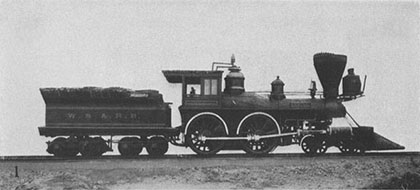
The “General” is preserved in Kennesaw and the “Texas” in Atlanta.
You can find out more about both locomotives and the “Great Locomotive Chase” on the Southern Museum and Great Locomotive Chase page of this website.
Left, Baltimore & Ohio #4045 was originally built by the Baldwin Locomotive Works, Philadelphia, PA, in 1911 as a Q-1 Class 2-8-2. It was rebuilt as a Q-1x and displayed at the fair. The rebuild replaced the original standard boiler with a water tube design by B&O Head of Motive Power, George H Emerson, as well as adding a tender booster.
#4045 may have later been converted
back to a standard boiler, but has not survived.
Right, Baltimore & Ohio Gas Electric Motor Car #6033, a 60’ steel car built in 1927 by the short-lived partnership of American Locomotive Company, General Electric and Ingersoll Rand. #6033 was designed for main line passenger service and could be coupled to one or two trailing cars.
Another B&O Gas Electric, #6008, may also have put in an appearance at the fair.

An 84 volt Exide battery is mounted under the rear part of the floor to provide a starting circuit to drive the generator. #15830 had a top speed of 60 mph.
Left, Oil Electric Motor Car #15830 was built by the Canadian National Railway in 1927. It is equipped with a 300 hp diesel engine from William Beardmore & Company Ltd., of Glasgow, Scotland, which drives a 198 kw 300 volt generator to power two traction motors mounted on the leading truck.
#15830 is seventy-three feet long and has seating for thirty-seven passengers, as well as a
smoking compartment and baggage space
Left, like BO #6033 shown earlier on this page, Oil Electric Switcher #40 was also built by the American Locomotive Company, General Electric and Ingersoll Rand.
It had two 300 hp oil engines driving two two 200 kw 600 volt generators to power four GE 200 hp traction motors.
Various other equipment was on display.
Right, B&O Steam Wrecking Crane X-75 was built in 1911 by the Industrial Works (later Industrial Brownhoist) in Bay City, MI. It was hauled to wreck sites to help with cleaning up and was scrapped in May 1975.
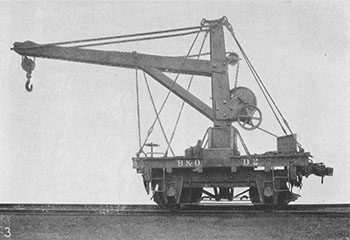
You can see photos of the derrick on the B&O Museum Roundhouse page of this website.
Left, a manually operated derrick D-2.
Right, a series of static exhibits were on display to demonstrate the development of the railroad passenger car including, from the top, the first ever Pullman Sleeping Car #9, which made its first trip on the night of 1st September 1859 from Bloomington to Chicago, IL, on the Chicago & Alton Line, an 1863 B&O Passenger Car and a modern Individual B&O Seat Coach. There was also an Entertainment Car equipped with a cinema, gymnasium and shower bath, barber shop and library-lounge. The development of different types of freight cars was shown by, amongst other exhibits, right, a Milk Tank Car and several refrigerator cars including, bottom, a Fruit Growers Express Car.
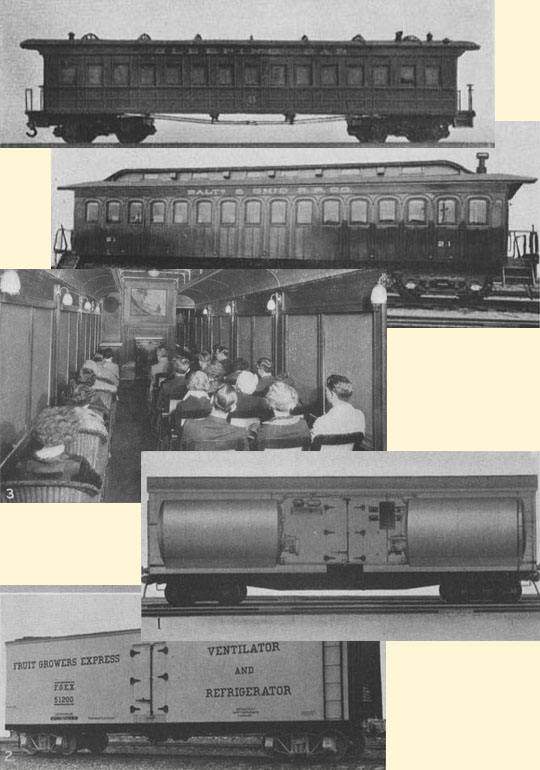
The five photos above from the two editions of the Centenary Catalogue.

The Traffic Building, located at the west end of the “Court of Honor”, was dedicated to demonstrating the development of material and structures ancillary to passenger and freight services. The main point of interest in the Traffic Building was, below, the scale model of the plant and equipment of the Baltimore & Ohio’s Locust Point Grain Elevator.
The concrete grain elevator had been constructed in 1924 to replace two wooden elevators that had recently been destroyed by fire. It was located to the south of Baltimore city on a site adjoining Fort McHenry.
The design was the result of careful study of the most modern examples in Canada and the US.
Other exhibits on display in the Traffic Building included:
Passenger train timetables, way-bills and rate sheets.
Advertising posters, pamphlets and newspaper clippings.
Freight way-bills and tariffs, and operating officials’ working schedules of passenger and freight trains.
Badges representing the different trades that took part in the 1828 parade celebrating the laying of the first stone.
Blue china with pictures of the early railroad made to commemorate its founding.
Plates used in the printing of stock certificates.
Script sold to the public by the B&O to finance building of the original line.
A piece of the original rail from the line between Mt. Clare and Carollton Viaduct, Old switch locks and historic lanterns.
Oil paintings of B&O Magazine cover designs, drawings and lithographs.
Aerial photographs of different locations on the B&O.
A bas relief map of the territory covered by the B&O.
Exhibits from the banker Alexander Brown and Sons.
A Travelers Aid Society stand staffed by two attendants.

The Allied Services Building located at the east end of the “Court of Honor” was dedicated to showing services ancillary to the railroad, such as the telegraph and telephone, shipping, express and mail services.
As well as twelve large model steamships, many paintings, posters, philatelic displays, photographs and relief maps, exhibits included, below, historic telephones, an 1844 Morse Register used on the B&O’s Baltimore-Washington line and a model of Samuel Morse’s original Morse Recorder.
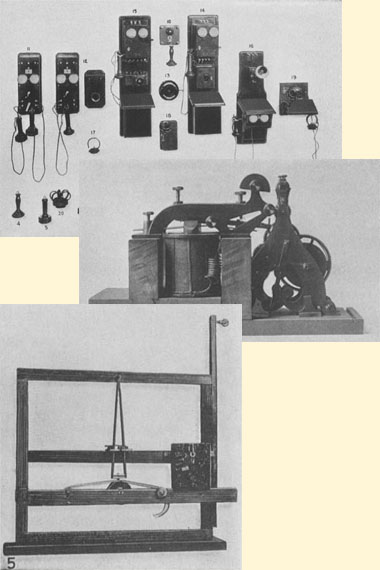
Photos from the Centenary Catalogue (first edition).

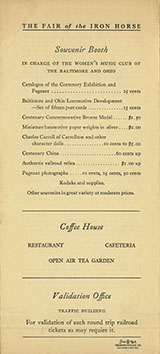
Above, the daily program touted the Souvenir Booth, which was “in charge of the Women’s Music Club of the Baltimore and Ohio".
“Charles Carrollton of Carrollton and other character dolls” were on sale, pageant photographs, small silver locomotive paper weights, pennants, “authentic railroad relics” and, right, a recording of the opening march, a fabric bookmark, letter opener, commemorative china, a brass medallion and small “Good Luck” tokens.
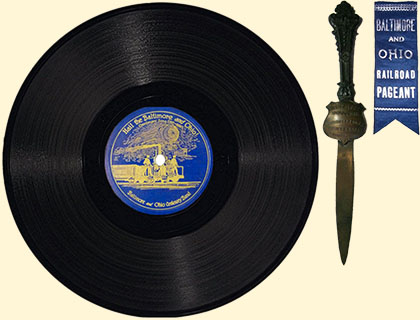

Above left, a soft cover 25c catalogue was on sale. Three more editions were published. Above right, the enlarged, final edition was published in hard back.
Below, a large souvenir programme appears to have been available free, with additional copies costing 10c.

Above, a set of fifteen
post-cards was also on sale.
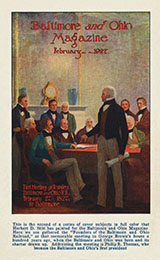
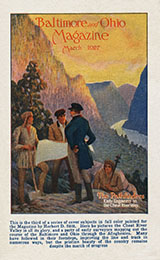
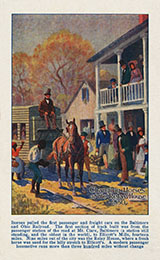
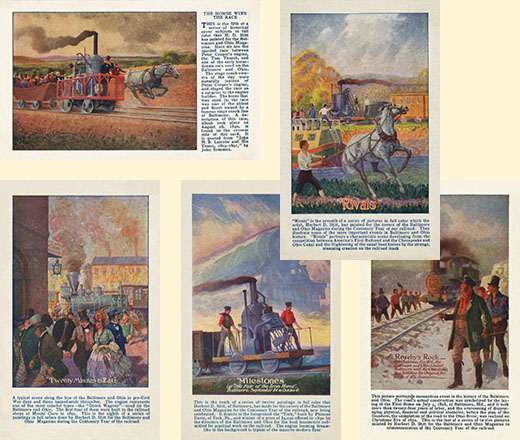
Another set of postcards featured the series of cover designs by H. D. Stitt for the 1927 editions of the Baltimore and Ohio Magazine.
Above, from the top left, designs for February, March, April, May, June, August, October and December.

Above and right, some examples of other postcards produced to promote the fair, either for sale in advance, at the time or after the fair had closed.
The top view, for example. appears to have been produced before the run was extended to 15th October, while the top right view, the commentary of which is written in the past tense, may have been printed after the fair had closed. The remaining two, by contrast, are highly topical and were probably on sale at the souvenir booth during the fair.
Note the bell fixed to GWR #6000 just outside the front pilot wheels. This was required for the locomotive's approval to operate on US railroad right of ways.


The Fair of the Iron Horse was the first major railroad fair in the world. Prior to 1927, locomotives had been displayed at World’s Fairs and industrial expositions, but nothing of this scale or complexity had been attempted before.
Although the pageant took its queue from the kinds of Parades of All Nations featured at these earlier events, with its period dress, trappings and re-enactments, the Fair became a blueprint for later stagings, such as the Wings of a Century
parade at the 1933 Chicago World’s Fair, the Railroads on Parade pageant at the 1939 New York Worlds Fair and the Chicago Railroad Fair of 1948-49.
Like the Fair of the Iron Horse, these successors offered a purview of transportation more widely, as well as enactors to add interest.
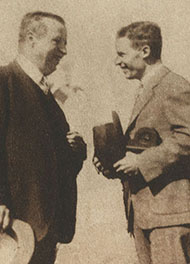
In 1925, Edward Hungerford (above right) journalist and author, approached Daniel Willard (above left) President of the B&O offering to write a history of the company, eventually published as “The Story of the Baltimore & Ohio Railroad 1827-1927” (available on the books and manuals page of this website).
Willard agreed but also hired Hungerford to oversee the planned pageant, and his success at this made him the "go to" guy for future events of this type.
Hungerford oversaw the production of five more transportation pageants, including the Wings of a Century parade at the 1933-34 Chicago World’s Fair, the Rochester Centennial of 1934, the Parade of the Years Pageant in 1936 in Cleveland, OH, and, lastly, the Railroads on Parade pageant for the 1939-40 New York World’s Fair.
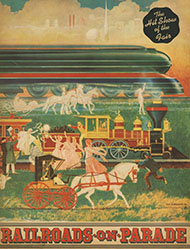
Many of the historic Baltimore & Ohio Railroad locomotives that took part in the Fair of the Iron Horse also attended these later events.
Between showings, they were stored, along with the other original models, paintings and historic material at the Hall of Transportation in Halethorpe.
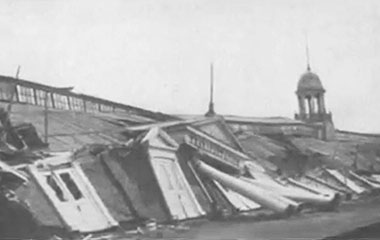
Then, on Tuesday 13th August 1935, disaster struck when a horrific overnight gale accompanied by lightning, rain and hail roared through the Baltimore area. Lighting hit a home in Alberton, Baltimore County, killing 18 year old Katherine Leila Lipscomb. Thousands of dollars worth of crops were ruined in Howard and Anne Arundel counties, while a shed filled with hay on New Cut Road near Ellicott City was struck by lightning and burned to the ground.
The storm winds caused the Hall of Transportation to collapse (above). The Pangborn collection of wooden models of early locomotives, arrayed along the west wall of the building, was crushed by the falling roof and destroyed. Three quarters of the Pangborn prints depicting the growth of railroading in the United States were lost. Fortunately, the larger locomotives lined up in the centre of the building apparently propped up the collapsed roof and saved other older, more fragile engines from damage.
After the debris had been cleared, the Baltimore & Ohio moved the surviving equipment to Bailey’s Roundhouse in Baltimore. After Bailey’s was torn down in 1953, the collection was moved to the current Baltimore & Ohio Railroad Museum site. You can see what survives of the collection, plus much more, on the B&O Railroad Museum Roundhouse and B&O Yard and Car Shop pages of this website.
Related Links:
A page of Fair of the Iron Horse publications
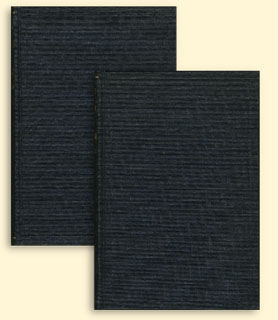
Right, Paul Winchester's Graphic Sketches from the History of the Baltimore & Ohio Railroad.
Click on the cover to download any of these books from the books & manuals page of this website.
Left, Volume II of Edward Hungerford's two volume The Story of the Baltimore & Ohio Railroad 1827-1927 has a very informative appendix with information on the Fair.
